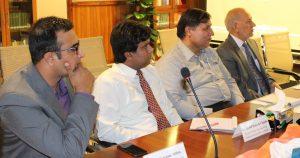Conference / Seminar / Webinar 20/06/2017
An eight-member delegation, led by Mr. Wu Sikang, President of Chinese Think Tank Association of Special Economic Zones visited Islamabad Policy Research Institute (IPRI) on June 09, 2017. Mr. Sikang is also the Director of Development Research Centre of Shenzhen’s Municipal People’s Government, China. From IPRI, Brig (R) Sohail Tirmizi, led the session in which Research Fellows, Col. (R) Muhammad Hanif, Mr. Muhamamd Munir and Mr. Khalid Chandio and Assistant Research Officers, Mr. Khurram Abbas and Ms. Maryam Nazir participated. The purpose of the visit to Pakistan by the Chinese Delegation was to project the success of Shenzhen as successful model of Special Economic Zone (SEZ), and to seek opportunities for business enterprises from Shenzhen to invest in the SEZs being established under CPEC.
In his opening remarks, Brig (R) Sohail Tirmizi, Acting President IPRI welcomed the Chinese delegation and remarked that Shenzhen is a great success story of economic development which is based entirely on innovative technologies. He said that during his visit to Shenzhen and Hong Kong in 1998, he was certain of the fact that Shenzhen would come out to be a success story with its establishment as an economic development zone as per Chinese policy. IPRI is grateful for this visit as for Pakistan; there is much to learn from Shenzhen. There could be no better people than Mr. Wu Sikang and his team of experts, who understand economic development, and can share the great secrets behind this achievement. To the best of our knowledge, out of many economic zones established by China, Shenzhen is leading as a model of success to be followed globally.
Mr. Wu Sikang in his opening remarks said that the delegation is happy to visit Pakistan, a country which is China’s closest strategic ally and friend. The discussion was started with a video presentation about the economic and social development in Shenzhen, China, specifically after its transformation into a Special Economic Zone (SEZ). It was mentioned that during 1998-2016, the GDP of Shenzhen has risen from US$ 20 billion to US$ 300 billion alongside an export-import volume of US$ 450 billion. More so, its port is ranked number three worldwide.
Mr. Sikang stated the Belt and Road initiative, proposed by President Xi Jinping is a grand agenda, of which CPEC is an integral part. While discussing the pre-requisites of such collaboration, he stated that the development of basic infrastructure such as ports, bridges, roads and airports etc, is considered to be the most important aspect besides the promotion of education and communication among individuals, entrepreneurs and cities. Mr. Sikang regarded ‘education’ as the secret of Shenzhen’s success. It was added that Shenzhen’s success is largely based on Industrial Transformation. Shenzhen was once known as a ‘fishing village’ with no industrial base but is now recognized as a ‘hub of global information and communication’.
Mr. Sikang also elaborated the strategies employed for the success of Shenzhen as SEZ. With the implementation of an open approach, a new culture of innovation, interaction and immigration was adopted, with primary emphasis on equality, pursuance of citizen rights and encouragement of foreign investors to invest. As an integral part of ‘innovation’ strategy, the agenda for the development of high-tech industry was proposed, which is why, around 80 enterprises of Shenzhen are contributing worth US$ 145 billion to the Chinese economy. Now, the emphasis has been onto transforming the national level enterprises into global sized enterprises. Another aspect which contributed to the development of Shenzhen is its proximity to the Hong Kong. Mr. Sikang said that biggest and developed cities are the motors and drivers of regional development. From Shezhen’s experience, it can be concluded that SEZ’s in the proximity of big cities have greater chances of success.
Q&A/Discussion session:
Q1: As Shenzhen is an innovation-driven economy, what percentage of the GDP is spent on the Research and Development (R&D)?
Delegation Head: Mr. Sikang said that around 4. 02 percent of the Shenzhen’s GDP is being spent on the R&D, which is a little less than Israel and close to that of Korea. He further added that our particular focus in R&D is on the enterprise development concerning enhanced productivity and higher industrialization.
Q2: With higher level of industrialization in China in general and Shenzhen, in particular, what has been its contribution percentage in carbon emissions?
Delegation Head: Mr. Sikang said that the administration in Shenzhen is well-observing the concept of ‘Green’ and environmental friendly, in which they have closed those enterprises which were not environment friendly. More so, in order to deal with climate change issues, the electricity driven buses have been launched on which US$ 1.2 billion have been spent.
Q3: Given the design of Shenzhen Special Economic Zone to attract foreign investment, what areas of SEZs must be focused to attract foreign investment in Pakistan?
Delegation Head: There are two approaches that are i) industries that best fit the resources of a particular area should be developed to facilitate an economic boost and ii) the development of hi-tech industries with a foresight to integrate them as a vital part of the international value chain such as robotics and intelligence. More so, as Pakistan has a large population which, if remains unskilled could be a big burden, it should be turned into one valuable resource through proper education and skill development.
Q4: Does the development of a Shenzhen’s new culture, in particular the before mentioned immigration culture in line with policy of Central Government in China?
Delegation Head: Mr. Sikang clarified that the before mentioned immigration policy as part of Shenzhen’s new culture is limited within China i.e. among its own cities. He added that Shenzhen welcomes people from all across China to come and settle there. Shenzhen’s proximity to Hong Kong is one key aspect which helps in attracting people and investment both. Such amalgamation of differing cultures and background is highly beneficial for innovation. The slogan of Shenzhen is also elaborative in this regard as it says, ‘if you come to Shenzhen, you belong to Shenzhen.’
Q5: What is the potential use of Robotics Industry in Pakistan which is majorly an agrarian country?
Delegation Head: Mr. Sikang said that its potential is more focused on the industrial side; however, in the specific case of agriculture, it can be involved in the processing of agricultural products such as post-processing of cotton.
Q6: There are nine SEZs designed under the framework of CPEC, can the Chinese model of Shenzhen be replicated in terms of benefits and output in Pakistan?
Delegation Head: Mr. Sikang opined that the Chinese can train Pakistan’s labor force about the use of technology and hi-tech industry. But before initiation, there is a need to have basic and comprehensive infrastructure to reach certain global standards of production and manufacturing. He said that today, Chinese goods can reach anywhere around the world within the time of 24 hours. On technology, it was said that there are rapid changes occurring in the sector and use of outdated technology can lead to elimination of potentially competitive enterprises. More so, there is a need to create financial centers as well, which could grant economic assistance to people interested in carrying out economically sustainable projects. Mr. Sikang added that SEZs have a close relationship with central, bigger and established cities and could give their maximum if located near to them.
Q7: Does the land use policy given to foreigners (with incentives) in 1970’s still exist in China, especially when the required development goals have been achieved?
Delegation Head: Mr. Sikang said that all those policies still exist which are consistent across the country, including tax relaxations and provision of utility services. However, it is for China to see that does it still need such incentives to attract investors in the future to design strategies accordingly.
In concluding remarks, Brig. (R) Sohail Tirmizi, Acting President, IPRI said that the intiative of CPEC is greatly valued in Pakistan. CPEC is one big project that Pakistan as a country has no such experience of, in terms of planning and implementation. However, the Government and agencies related to it are trying their best in coming up with required legislations, establishment of projects including SEZs and the provision of security. It was opined that alongside Pakistan, China will also have certain benefits of CPEC in specific and Belt and Road Initiative, in general. Even for a success story like Shenzhen, distance to the Arabian Sea will be reduced through CPEC. For Shenzhen, major cities like Lahore, Multan, Karachi, Hyderabad, Peshawar and Quetta could be the possible future locations of engagement.
Conclusion: The establishment of SEZs is considered to be the backbone of the entire CPEC framework for which a detailed study of already existing models is required. The development of Shenzhen as a SEZ may be studied as it has been the most successful event in China.
Disclaimer: Views expressed are of the speakers and are not necessarily reflective of IPRI policy.


